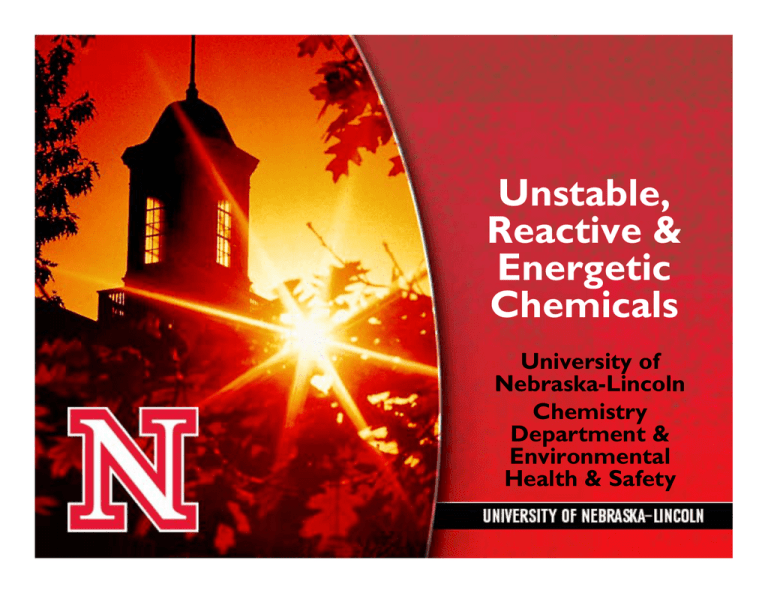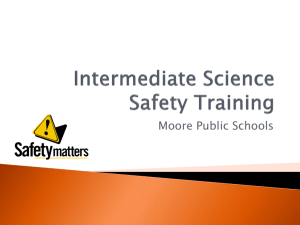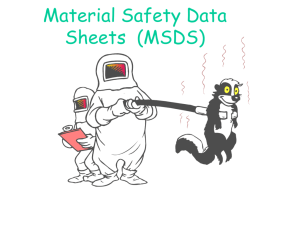Unstable, Reactive & Energetic Chemicals
advertisement

Unstable, Reactive & Energetic Chemicals University of Nebraska-Lincoln Chemistry Department & Environmental Health & Safety Background • Unstable, reactive and energetic compounds use at colleges and universities has come under scrutiny – US Chemical Safety and Hazard Investigation Board (CSB) – Occupational Health and Safety Administration (OSHA) • Why? – Recent accidents Texas Tech, January 20, 2010 Texas Tech, January 20, 2010 • Graduate student was synthesizing a known energetic chemical (a nickel hydrazine perchlorate derivative) • Had no formal training with the material/hazards • Exceeded limits allowed to synthesize (limit 100 mg; made 10 gm) • No PPE (not even safety glasses) • Was ‘gently’ grinding in a mortal and pestle • Lost three fingers and permanently damaged one eye • UNMC 1993 similar incident but with a triperoxide. Graduate student lost one finger and damaged two others. University of California Los Angeles, December 29, 2009 University of California Los Angeles, December 29, 2009 • Graduate student was drawing pentane containing tertbutyl lithium into a syringe • Had no proper training • Syringe came apart in her hands • Suffered third degree burns to 43% of her body • Died 18 days later • Was not wearing any PPE • Clothing she was wearing was synthetic and flammable • Initially ran away from a safety shower before running to it • The UCLA Regents and graduate student’s professor are currently facing criminal charges Other Incidents • January 2012 – sodium azide explosion; graduate student hospitalized with serious burns to hands, body, and face – Similar incident Oct 2011 (from attempting to scrape 4g of NaN3 out of a vial) • May 2011 – HCl and TiCl4 explosion (water was involved), graduate student hospitalized with severe cut to arm and acid in eyes • 2010-2011 – Several cases of students hospitalized following explosions of demonstrations involving heating of nitrates with sugars or glycerin • What about UNL? September 1990, Hamilton Hall • Graduate student attempting to recycle tetrahydrofuran: – Unclear if any stabilizer remained in solvent. – Distilled under air (favoring peroxide formation) – No reducing agent employed to destroy peroxides. • Resulting explosion sent shards of flask through hood sash, severely lacerating student. • The explosion shattered additional bottles of used THF (16L) stored adjacent to apparatus. The resulting explosion and fire destroyed the hood completely and badly damaged the lab. • Water damage from a broken pipe reached the basement Hazard Assessments are Needed • Also called a ‘Job Safety Assessment’ (JSA) • Consists of: – Identifying hazards – Identifying receptors • What is at risk (equipment, people, etc.) – Evaluating risks • Includes the likelihood of something going wrong and • The magnitude of the consequences – Actions to eliminate hazards and minimize risk Identify Hazards – MSDS Part 1 • Material Safety Data Sheet (MSDS) – One of the most important sources for information – Read even for chemicals you are going to synthesize on your own (if available) – Read one from the product manufacturer • Not all MSDSs are created equal – Read others: • Fisher Scientific • Sigma-Aldrich • Avantor (previously JT Baker/Mallinckrodt) • My experience is that many fail to read and fully understand the MSDS Identify Hazards – MSDS Part 2 • Understand the warnings, examples: – Spontaneously combustible means the material can begin to burn without an obvious external ignition source – Pyrophoric means the material can ignite spontaneously in air – Air reactive might mean the product is pyrophoric…or it might just mean it degrades when exposed to air – Other important warnings: • Shock sensitive, peroxide-former, water reactive, unstable, uninhibited, monomer, explosive, violent Identify Hazards – MSDS Part 3 • Read the section on incompatibilities – Does the work expose the chemical to anything listed? – As a chemist, incompatibilities might be just what you are looking for • Read the MSDS critically (example; sodium azide): – The Department of Transportation (DOT) classifies it as a poison – The National Fire Protection Agency (NFPA) classifies it as an extreme health hazard but just a moderate reactivity (explosive) hazard – The MSDS indicates it can explode when heated, create shock sensitive compounds, or evolve toxic gases worries me more Identify Hazards - Beyond MSDS • Read the label on the container – The language should agree with the MSDS – If anything is different, find out why – I have seen container labels describe greater hazards than what was found on an MSDS • Read other literature – Manufacturer product use – Research papers and protocols • Very important for chemicals not commercially available (likely no MSDS available) • Same concepts as for MSDSs apply – Standard operating procedures Specific Chemicals/Classes • • • • • • • • • Azides Picrates Nitro compounds Peroxide-formers Metal hydrides Low-molecular weight alkynes Reactive organo-metallics Organic peroxides Others? Azides • Sodium azide is the most common – Water soluble – Most common use is as an anti-microbial – Also used to inflate vehicle air-bags – Can explode if heated – Spontaneously forms insoluble shock sensitive compounds when exposed to some metals/salts and metal surfaces (generally avoid any metals; any metals salts other than salts of alkalai metals) • Copper drain pipes have been as source of explosions Picrates • Most common are picric acid and picrylsulfonic acid – Both are tri-nitrophenol based compounds – Most commonly used as biological stains – Relatively water soluble – When dry can detonate if initiated – Spontaneously form insoluble shock sensitive compounds when exposed to metals/salts and metal surfaces – Friction with dried chemical in container lids is reportedly a source of detonations. Do not attempt to open old or “discovered” bottles of picric acid. Perchloric Acid/Perchlorates • Perchloric acid was once widely used for digestion of biological samples. But: – Spontaneously ignites or explodes in presence of oxidizable organics. – Vapors create shock-sensitive perchlorates in exhaust ventilation. • Alkali metal perchlorates relatively safe. However, avoid any exposure to heavier metals or their salts (Ag, Pb, etc.) as these perchlorates are extremely shock-sensitive. (Note: mercuric perchlorate sometimes still used as a reagent.) Nitro Compounds • Related to picric acid and picrylsulfonic acid • The ratio of molecule size to number of nitro group substitutions is the concern – Nitrotoluene is not much of a problem – Trinitrotoluene (TNT) is – Nitrocellulose is poly-nitrated • Common into the 1950s for making movie film, photographic negatives, and wood sealers • Is it the degree of nitration that separates flammable solids from explosives? • Stability varies; some (nitrocellulose) can become unstable over time Peroxide-Formers • Consist of some ethers and aldehydes, p-dioxane, THF, some alkenes and amides, and styrene among others • Over time can develop -O-O- bonds which are unstable – Risk of peroxide formation is chemical and use specific • Some products are ‘inhibited’ (i.e. contain a chemical to scavenge oxygen) – Inhibitors are eventually used up – Distilling solvents also leaves the inhibitor behind as a still bottom • Beware the ‘light’ container that should have had more within it Metal Hydrides • Examples include sodium hydride and lithium aluminum hydride • Used as reducing agents in organic chemistry • Will spontaneously ignite on exposure to the air • Will react violently with water • Are usually dispersed in mineral oil Low Molecular Weight Alkynes • • • • • Ethyne (acetylene) is the most common Used in organic chemistry synthesis reactions Some polymerize spontaneously Most are very reactive Acetylene must be dissolved in acetone for safe use and can be only moderately compressed Reactive Organo-Metallics • • • • • N-butyl lithium is one of the most common Can be used as a ‘superbase’ in organic synthesis reactions Most are dissolved in an organic (flammable) solvent Are water reactive Moisture in the air can result in reactions that lead to fires Organic Peroxides • Are characterized by an -O-O- bond • Benzoyl peroxide and methyl ethyl ketone peroxide are examples • Sometimes used to initiate polymerization reactions • Combine an oxidizing functional group with oxidizable organics • Some are shock and/or temperature-sensitive – SADT (self accelerating decomposition temperature) • Some are below room temperature • Others ignite easily and burn intensely Hazard Assessment Recap • Identify hazards – – DONE • Identify receptors – What is at risk (equipment, people, etc.) • Evaluate risks – Includes the likelihood of something going wrong and – The magnitude of the consequences • Actions to eliminate hazards and minimize risk Identify Receptors • This one is simple • The receptor is you and/or your coworkers Evaluate Risks • If used improperly, the risk of something going wrong is high • The potential magnitude of the consequences are very high – Amputations – Shrapnel injuries – Thermal and/or chemical burns – Significant exposure to toxic chemicals – Death Hazard Elimination • Are less dangerous alternatives available? – For sodium azide there is an alternate anti-microbial from Kathon® Preservatives • For other products used in a research setting, options might be limited • Now what? Minimize Risk • Read, understand, and follow MSDSs and other safety information • Understand procedures used to transfer or otherwise handle chemicals. These should be: – Written – Reviewed by the Principle Investigator & lab workers – Kept readily accessible for easy reference • Where possible, practice transfers and other chemical manipulations using safe substitutes or do ‘dry runs’ • Have other, more experienced researchers ‘critique’ your transfers and other manipulations Minimize Risk • Do not vary from established protocols and research work unless approved by professors/supervisors • Reaction scale – many are lethal at a mole scale but not at a millimole scale • Wear appropriate PPE – Lab coats; flame retardant ones are available – Safety glasses/goggles – Face shield • Closed toe shoes • Long pants • Avoid synthetics; even those that don’t burn are likely to melt onto your body; wear cotton or wool instead Minimize Risk • Use fume hoods and other shielding equipment as much as possible – Place horizontal hood sashes in front – Keep vertical hood sashes down – Use a portable transparent shield • Properly secure all apparatus – This includes product containers where appropriate • Minimize other chemicals in the hood – If something goes wrong; there is less chemical available to react • Do multiple things right Closing Thoughts • Read the articles in the links provided for the UCLA prosecution and UNMC case • In the UNMC case especially, note how the court evaluated the responsibilities of both the graduate student and professor – This will likely be the standard to which all parties will be held in the event of an incident • See also the ACS Task Force draft report ‘Creating Safety Cultures in Academic Institutions’ EHS SOPs • JOB SAFETY ASSESSMENTS – http://ehs.unl.edu/sop/s-JSA.pdf • USE AND STORAGE OF PEROXIDE-FORMING CHEMICALS – http://ehs.unl.edu/sop/s-peroxides.pdf • PYROPHORIC CHEMICALS – http://ehs.unl.edu/sop/s-pyrophoric_chemicals.pdf Other Information Sources • Aldrich Technical Bulletin AL-134 Handling Air Sensitive Reagents • Aldrich Technical Bulletin AL-164 Handling Pyrophoric Reagents • EHS Colloquium on Pyrophorics – http://ehs.unl.edu/training/Colloquium/ Questions/Comments? ©2007 The Board of Regents of the University of Nebraska. All rights reserved.





